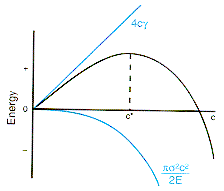|
||||||||||||
|
||||||||||||
| Griffith
developed a continuum model for initiation of fracture by crack growth,
equating the surface energy required to enlarge a crack to the release
in elastic strain energy in the material as a function of the increase
in crack length. He argued that a crack propagates when these two
quantities are equal, i.e. the total energy of the system was constant.
The diagram shows the balance between the crack surface energy, 4gc,
and the stored elastic energy, ps2c2/2E,
as a function of the crack size. The total energy reaches a maximum at
the critical crack size, c*.
Following Griffith, the stress intensity factor at a crack tip can be defined
as: K = Y
s (c)0.5,
and a critical value for this quantity is KCR
= Y sCR
(c*)0.5.
Y is a sample geometry term.
|
||||||||||||
 |
||||||||||||
| From:
McMahon and Graham,
Introduction to Engineering Materials," Merion (1992) |
||||||||||||
| Regrouping
gives the critical crack size for a given applied tensile stress:
sCR = KCR/Y(c)0.5. The critical crack size, the largest flaw survives for a given applied stress is: cMAX=(KCR/Ys)2. Once the critical stress is reached, fast fracture occurs with the upper limit of the crack tip velocity the speed of sound. |
||||||||||||